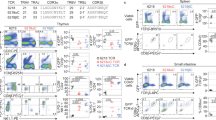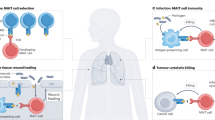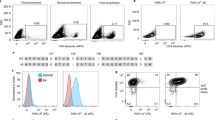Abstract
To initiate an immune response, key receptor-ligand pairs must cluster in “immune synapses” at the T cell–antigen-presenting cell (APC) interface. We visualized the accumulation of a major histocompatibility complex (MHC) class II molecule, I-Ek, at a T cell–B cell interface and found it was dependent on both antigen recognition and costimulation. This suggests that costimulation-driven active transport of T cell surface molecules helps to drive immunological synapse formation. Although only agonist peptide–MHC class II (agonist pMHC class II) complexes can initiate T cell activation, endogenous pMHC class II complexes also appeared to accumulate. To test this directly, we labeled a “null” pMHC class II complex and found that, although it lacked major TCR contact residues, it could be driven into the synapse in a TCR-dependant manner. Thus, low-affinity ligands can contribute to synapse formation and T cell signaling.
This is a preview of subscription content, access via your institution
Access options
Subscribe to this journal
Receive 12 print issues and online access
$209.00 per year
only $17.42 per issue
Buy this article
- Purchase on Springer Link
- Instant access to full article PDF
Prices may be subject to local taxes which are calculated during checkout



Similar content being viewed by others
References
Monks, C. R., Freiberg, B. A., Kupfer, H., Sciaky, N. & Kupfer, A. Three-dimensional segregation of supramolecular activation clusters in T cells. Nature 395, 82–86 (1998).
Grakoui, A. et al. The immunological synapse: A molecular machinery controlling T cell activation. Science 285, 221–226 (1999).
Krummel, M. F., Sjaastad, M. D., Wülfing, C. & Davis, M. M. Differential clustering of CD4 and CD3ζ during T cell recognition. Science 289, 1349–1352 (2000).
Wülfing, C., Bauch, A., Crabtree, G. R. & Davis, M. M. The vav exchange factor is an essential regulator in actin-dependent receptor translocation to the lymphocyte-antigen-presenting cell interface. Proc. Natl Acad. Sci. USA 97, 10150–10155 (2000).
Dustin, M. L. & Shaw, A. S. Costimulation: building an immunological synapse. Science 283, 649–650 (1999).
Kupfer, A. & Singer, S. J. Cell biology of cytotoxic and helper T cell functions: immunofluorescence microscopic studies of single cells and cell couples. Annu. Rev. Immunol. 7, 309–337 (1989).
Singer, S. J. Intercellular communication and cell-cell adhesion. Science 255, 1671–1677 (1992).
Wülfing, C. & Davis, M. M. A receptor/cytoskeletal movement triggered by costimulation during T cell activation. Science 282, 2266–2270 (1998).
Viola, A., Schroeder, S., Sakakibara, Y. & Lanzavecchia, A. T lymphocyte costimulation mediated by reorganization of membrane microdomains. Science 283, 680–682 (1999).
Blair, P. J. et al. CD28 co-receptor signal transduction in T-cell activation. Biochem. Soc. Trans. 25, 651–657 (1997).
Chambers, C. A. & Allison, J. P. Co-stimulation in T cell responses. Curr. Opin. Immunol. 9, 396–404 (1997).
Sperling, A. I. & Bluestone, J. A. The complexities of T-cell co-stimulation: CD28 and beyond. Immunol. Rev. 153, 155–182 (1996).
Dustin, M. L. & Springer, T. A. T-cell receptor cross-linking transiently stimulates adhesiveness through LFA-1. Nature 341, 619–624 (1989).
Stewart, M. & Hogg, N. Regulation of leukocyte integrin function: affinity vs. avidity. J. Cell. Biochem. 61, 554–661 (1996).
van Kooyk, Y. & Figdor, C. G. Signalling and adhesive properties of the integrin leucocyte function-associated antigen 1 (LFA-1). Biochem. Soc. Trans. 25, 515–520 (1997).
Boise, L. H. et al. CD28 costimulation can promote T cell survival by enhancing the expression of Bcl-XL . Immunity 3, 87–98 (1995).
Shapiro, V. S., Mollenauer, M. N. & Weiss, A. Nuclear factor of activated T cells and AP-1 are insufficient for IL-2 promoter activation: requirement for CD28 up-regulation of RE/AP. J. Immunol. 161, 6455–6458 (1998).
Davis, M. M., Chien, Y. H., Gascoigne, N. R. & Hedrick, S. M. A murine T cell receptor gene complex: isolation, structure and rearrangement. Immunol. Rev. 81, 235–258 (1984).
Lo, D., Ron, Y. & Sprent, J. Induction of MHC-restricted specificity and tolerance in the thymus. Immunol. Res. 5, 221–232 (1986).
Goldrath, A. W. & Bevan, M. J. Selecting and maintaining a diverse T-cell repertoire. Nature 402, 255–262 (1999).
Tanchot, C., Lemonnier, F. A., Pérarnau, B., Freitas, A. A. & Rocha, B. Differential requirements for survival and proliferation of CD8 naïve or memory T cells. Science 276, 2057–2062 (1997).
Takeda, S., Rodewald, H. R., Arakawa, H., Bluethmann, H. & Shimizu, T. MHC class II molecules are not required for survival of newly generated CD4+ T cells, but affect their long-term life span. Immunity 5, 217–228 (1996).
Brocker, T. Survival of mature CD4 T lymphocytes is dependent on major histocompatibility complex class II-expressing dendritic cells. J. Exp. Med. 186, 1223–1232 (1997).
Rooke, R., Waltzinger, C., Benoist, C. & Mathis, D. Targeted complementation of MHC class II deficiency by intrathymic delivery of recombinant adenoviruses. Immunity 7, 123–134 (1997).
Motyka, B. & Teh, H. S. Naturally occurring low affinity peptide-MHC class I ligands can mediate negative selection and T cell activation. J. Immunol. 160, 77–86 (1998).
Williams, C. B., Engle, D. L., Kersh, G. J., Michael White, J. & Allen, P. M. A kinetic threshold between negative and positive selection based on the longevity of the T cell receptor-ligand complex. J. Exp. Med. 189, 1531–1544 (1999).
Berg, L. J. et al. Antigen/MHC-specific T cells are preferentially exported from the thymus in the presence of their MHC ligand. Cell 58, 1035–1046 (1989).
Seder, R. A., Paul, W. E., Davis, M. M. & Fazekas de St. Groth, B. The presence of interleukin 4 during in vitro priming determines the lymphokine-producing potential of CD4+ T cells from T cell receptor transgenic mice. J. Exp. Med. 176, 1091–1098 (1992).
Wülfing, C., Sjaastad, M. D. & Davis, M. M. Visualizing the dynamics of T cell activation: ICAM-1 migrates rapidly to the T cell:B cell interface and acts to sustain calcium levels. Proc. Natl Acad. Sci. USA 95, 6302–6307 (1998).
Wubbolts, R. et al. Direct vesicular transport of MHC class II molecules from lysosomal structures to the cell surface. J. Cell Biol. 135, 611–622 (1996).
Reay, P. A., Kantor, R. M. & Davis, M. M. Use of global amino acid replacements to define the requirements for MHC binding and T cell recognition of moth cytochrome c (93–103). J. Immunol. 152, 3946–3957 (1994).
Lyons, D. S. et al. A T cell receptor binds to antagonist ligands with lower affinities and faster dissociation rates than to agonists. Immunity 5, 53–61 (1996).
Wülfing, C. et al. Kinetics and extent of T cell activation as measured with the calcium signal. J. Exp. Med. 185, 1815–1825 (1997).
Valitutti, S., Dessing, M., Aktories, K., Gallati, H. & Lanzavecchia, A. Sustained signaling leading to T cell activation results from prolonged T cell receptor occupancy. Role of T cell actin cytoskeleton. J. Exp. Med. 181, 577–584 (1995).
Holsinger, L. J. et al. Defects in actin-cap formation in Vav-deficient mice implicate an actin requirement for lymphocyte signal transduction. Curr. Biol. 8, 563–572 (1998).
Konig, R., Huang, L. Y. & Germain, R. N. MHC class II interaction with CD4 mediated by a region analogous to the MHC class I binding site for CD8. Nature 356, 796–798 (1992).
Cammarota, G. et al. Identification of a CD4 binding site on the β2 domain of HLA-DR molecules. Nature 356, 799–801 (1992).
Jorgensen, J. L., Esser, U., Fazekas de St. Groth, B., Reay, P. A. & Davis, M. M. Mapping T-cell receptor-peptide contacts by variant peptide immunization of single-chain transgenics. Nature 355, 224–230 (1992).
Glimcher, L. H. & Kara, C. J. Sequences and factors: a guide to MHC class-II transcription. Annu. Rev. Immunol. 10, 13–49 (1992).
Mach, B., Steimle, V., Martinez-Soria, E. & Reith, W. Regulation of MHC class II genes: lessons from a disease. Annu. Rev. Immunol. 14, 301–331 (1996).
Jung, P. & Wiesenfeld, K. Too quiet to hear a whisper. Nature 385, 291 (1997).
Davis, S. J. & van der Merwe, P.A. The structure and ligand interactions of CD2: implications for T-cell function. Immunol. Today 17 177–187 (1996).
Al-Alwan, M. M., Rowden, G., Lee, T. D. & West, K. A. The dendritic cell cytoskeleton is critical for the formation of the immunological synapse. J. Immunol. 166, 1452–1456 (2001).
Manning, T. C. et al. Alanine scanning mutagenesis of an αβ T cell receptor: mapping the energy of antigen recognition. Immunity 8, 413–425 (1998).
Sandberg, J. K., Kärre, K. & Glas, R. Recognition of the major histocompatibility complex restriction element modulates CD8(+) T cell specificity and compensates for loss of T cell receptor contacts with the specific peptide. J. Exp. Med. 189, 883–894 (1999).
Anderson, M. T. et al. Simultaneous fluorescence-activated cell sorter analysis of two distinct transcriptional elements within a single cell using engineered green fluorescent proteins. Proc. Natl Acad. Sci. USA 93, 8508–8011 (1996).
Wettstein, D. A., Boniface, J. J., Reay, P. A., Schild, H. & Davis, M. M. Expression of a class II major histocompatibility complex (MHC) heterodimer in a lipid-linked form with enhanced peptide/soluble MHC complex formation at low pH. J. Exp. Med. 174, 219–228 (1991).
Yelon, D., Schaefer, K. L. & Berg, L. J. Alterations in CD4-binding regions of the MHC class II molecule I-Ek do not impede CD4+ T cell development. J. Immunol. 162, 1348–1358 (1999).
Riberdy, J. M., Mostaghel, E. & Doyle, C. Disruption of the CD4-major histocompatibility complex class II interaction blocks the development of CD4(+) T cells in vivo. Proc. Natl Acad. Sci. USA 95, 4493–4498 (1998).
Mostaghel, E. A., Riberdy, J. M., Steeber, D. A. & Doyle, C. Coreceptor-independent T cell activation in mice expressing MHC class II molecules mutated in the CD4 binding domain. J. Immunol. 161, 6559–6566 (1998).
Gilfillan, S., Shen, X. & König, R. Selection and function of CD4+ T lymphocytes in transgenic mice expressing mutant MHC class II molecules deficient in their interaction with CD4. J. Immunol. 161, 6629–6637 (1998).
Baldwin, K. K., Reay, P. A., Wu, L., Farr, A. & Davis, M. M. A T cell receptor-specific blockade of positive selection. J. Exp. Med. 189, 13–24 (1999).
Kimachi, K., Croft, M. & Grey, H. M. The minimal number of antigen-major histocompatibility complex class II complexes required for activation of naive and primed T cells. Eur. J. Immunol. 27, 3310–3317 (1997).
Dadaglio, G., Nelson, C. A., Deck, M. B., Petzold, S. J. & Unanue, E. R. Characterization and quantitation of peptide-MHC complexes produced from hen egg lysozyme using a monoclonal antibody. Immunity 6, 727–738 (1997).
Chan, P. Y. et al. Influence of receptor lateral mobility on adhesion strengthening between membranes containing LFA-3 and CD2. J. Cell Biol. 115, 245–255 (1991).
Acknowledgements
We thank M. F. Krummel, R. M. Kantor and N. J. Burroughs for helpful discussions. OG-gEk was a gift of E. Hailman. Supported by grants from the Howard Hughes Medical Institute and the National Institutes of Health (to M. M. D.) as well as the Cancer Research Fund of the Damon Runyon Walter Winchell Foundation (L. C. W.).
Author information
Authors and Affiliations
Corresponding author
Additional information
Note: Supplementary information can be found on the Nature Immunology website (http://immunology.nature.com/supp_info/).
Supplementary information
Web Movie 1.
I-Eκ accumulates at the T cell-APC interface: time lapse. The interaction of a 5C.C7 T cell with an A20.I-Eκ cell, peptide loaded with 10 µM agonist peptide, is shown. A bright field series of images has been duplicated and is overlaid with false-color encoded fluorescence information. The top panel is overlaid with a false-color representation of the intracellular calcium concentration of the T cell ranging from blue (low) to red (high calcium concentration). In the bottom panel the I-Eκ-GFP fluorescence of the B cell lymphoma is overlaid in a rainbow color scale from blue (low) to red (high GFP fluorescence). For presentation purposes the blue color has been thresholded out. The I-Eκ-GFP fluorescence has been collected in 21 z-planes, of which only the middle one is shown. The movie shows that I-Eκ-GFP accumulates at the T cell-B cell interface; the accumulation in this particular cell couple is concentrated. The movie compresses 14 min of experiment into 42 s of movie. (MOV 717 kb)
Web Movie 2.
I-Eκ accumulates at the T cell-APC interface: 3D images at selected timepoints. This is derived from the same experiment as Movie 1. A 3D reconstruction of the I-Eκ-GFP fluorescence of the A20.I-Eκ cell interacting with the 5C.C7 T cell from Movie 1 is shown at four timepoints. The position of the T cell-APC interface is visible as a flattening of the bottom left area of the A20 cells. The timepoints from top left to bottom right are: the time of the formation of the T cell-B cell interface and 3 min, 6 min and 9 min afterwards. The I-Eκ-GFP fluorescence color scale is the same as in Movie 1 but without thresholding. The 3D reconstructions are sequentially rotated in 15-degree increments around a horizontal and vertical axis. In this particular experiment the accumulation is concentrated. (MOV 1984 kb)
Rights and permissions
About this article
Cite this article
Wülfing, C., Sumen, C., Sjaastad, M. et al. Costimulation and endogenous MHC ligands contribute to T cell recognition. Nat Immunol 3, 42–47 (2002). https://doi.org/10.1038/ni741
Received:
Accepted:
Published:
Issue Date:
DOI: https://doi.org/10.1038/ni741
This article is cited by
-
Nonstimulatory peptide–MHC enhances human T-cell antigen-specific responses by amplifying proximal TCR signaling
Nature Communications (2018)
-
A cycle of Zap70 kinase activation and release from the TCR amplifies and disperses antigenic stimuli
Nature Immunology (2017)
-
Mapping quantitative trait loci (QTL) for body weight, length and condition factor traits in backcross (BC1) family of Common carp (Cyprinus carpio L.)
Molecular Biology Reports (2014)
-
Genetic Diversity of Selected Iranian Quinces Using SSRs from Apples and Pears
Biochemical Genetics (2013)
-
How the TCR balances sensitivity and specificity for the recognition of self and pathogens
Nature Immunology (2012)



